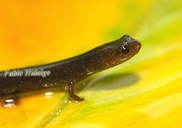|
Oedipina uniformis Keferstein, 1868
Common Worm Salamander, Costa Rican Worm Salamander Subgenus: Oedipina | family: Plethodontidae subfamily: Hemidactyliinae genus: Oedipina |
 © 2013 Fabio Hidalgo (1 of 16) |
|
|
|
Description Distribution and Habitat Country distribution from AmphibiaWeb's database: Costa Rica
Life History, Abundance, Activity, and Special Behaviors Trends and Threats Possible reasons for amphibian decline Intensified agriculture or grazing Comments A Spanish-language species account can be found at the website of Instituto Nacional de Biodiversidad (INBio).
References
Dodd, C. K., Jr. and Brodie, E. D., III (1976). ''Defensive mechanisms of Neotropical salamanders with an experimental analysis of immobility and the effect of temperature on immobility.'' Herpetologica, 32(3), 269-290. García-París, M., Good., D. A., Parra-Olea, G., and Wake, D. B. (2000). ''Biodiversity of Costa Rican salamanders: implications of high levels of genetic differentiation and phylogeographic structure for species formation.'' Proceedings of the National Academy of Sciences, 97(4), 1640-1647. Green, D. M. (1991). ''Supernumerary chromosomes in amphibians.'' Amphibian Cytogenetics and Evolution. D.M. Green and S.K. Sessions, eds., Academic Press, San Diego, California, USA. Guyer, C., and Donnelly, M. A. (2005). Amphibians and Reptiles of La Selva, Costa Rica and the Caribbean Slope: A Comprehensive Guide. University of California Press, Berkeley. Kezer, J., Sessions, S. K., and Leon, P. (1989). ''The meiotic structure and behavior of the strongly heteromorphic X/Y sex chromosomes of Neotropical plethodontid salamanders of the genus Oedipina.'' Chromosoma, 98, 433-442. Leenders, T. (2001). A Guide to Amphibians And Reptiles of Costa Rica. Zona Tropical, Miami. Sessions, S. K., and Kezer, J. (1991). ''Evolutionary cytogenetics of bolitoglossine salamanders (family Plethodontidae).'' Amphibian Cytogenetics and Evolution. D.M. Green and S.K. Sessions, eds., Academic Press, San Diego, California, USA. Wake, D. B. (2003). ''Costa Rican worm salamander, Oedipina uniformis.'' Grzimek's Animal Life Encyclopedia, Volume 6, Amphibians. 2nd edition. M. Hutchins, W. E. Duellman, and N. Schlager, eds., Gale Group, Farmington Hills, Michigan. Originally submitted by: Peera Chantasirivisal (first posted 2005-11-04) Edited by: Kellie Whittaker (2009-11-04) Species Account Citation: AmphibiaWeb 2009 Oedipina uniformis: Common Worm Salamander <https://amphibiaweb.org/species/4117> University of California, Berkeley, CA, USA. Accessed May 23, 2025.
Feedback or comments about this page.
Citation: AmphibiaWeb. 2025. <https://amphibiaweb.org> University of California, Berkeley, CA, USA. Accessed 23 May 2025. AmphibiaWeb's policy on data use. |




 Raffaëlli Account
Raffaëlli Account Map of Life
Map of Life